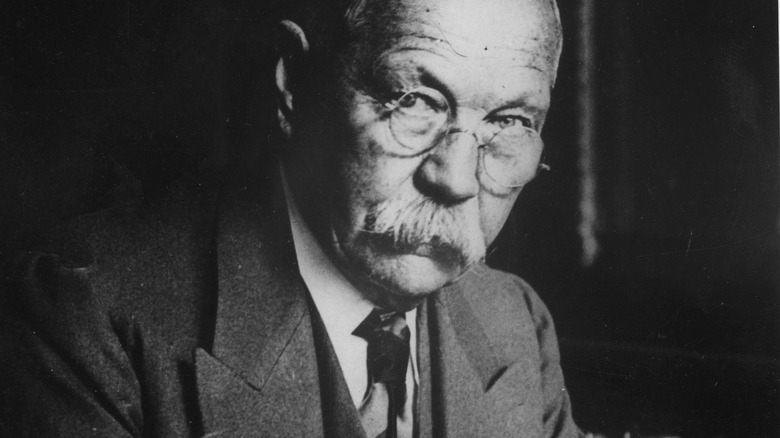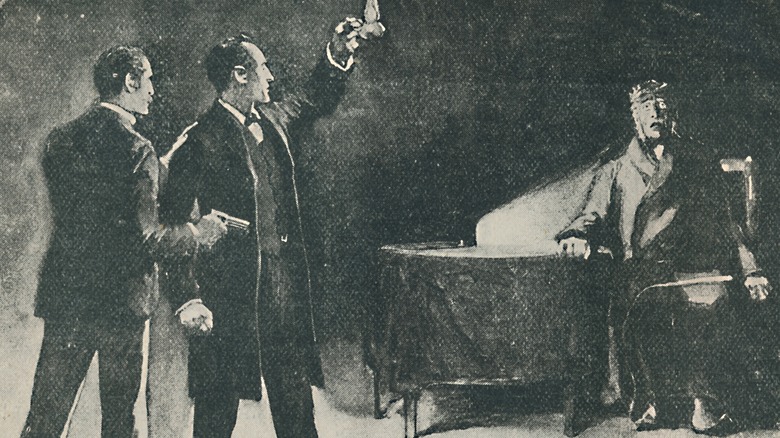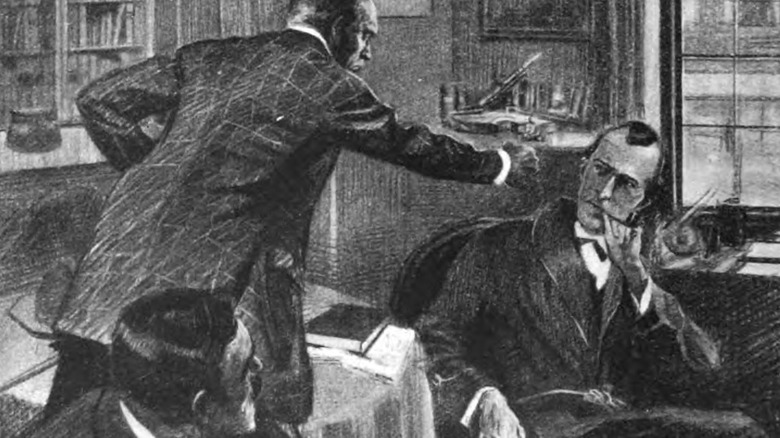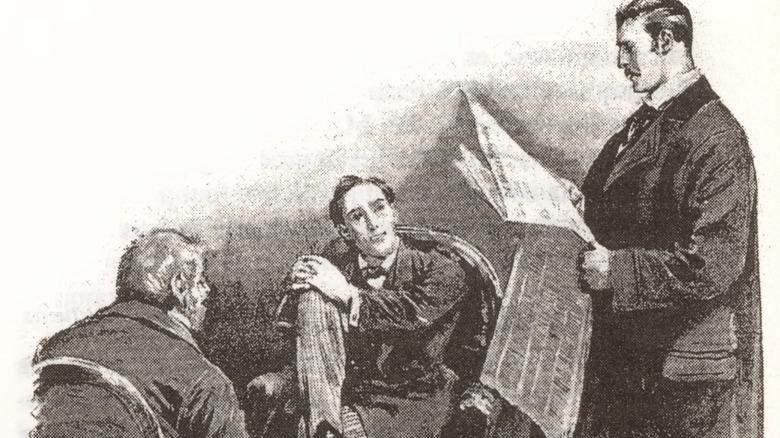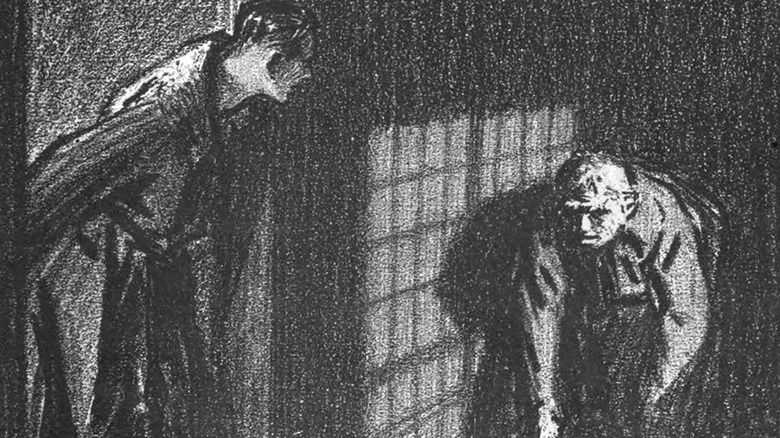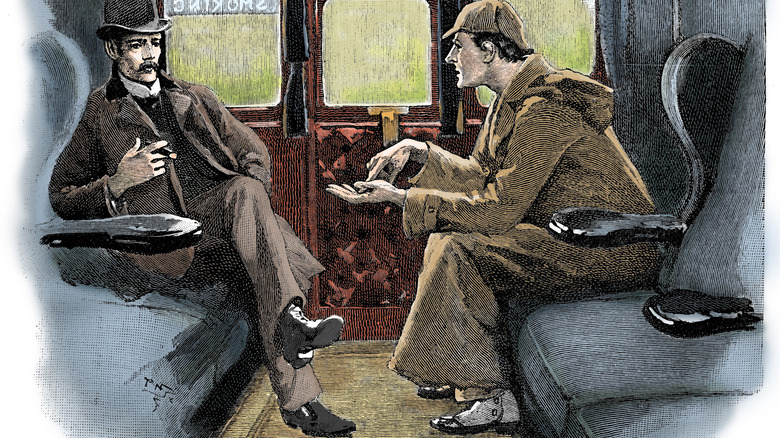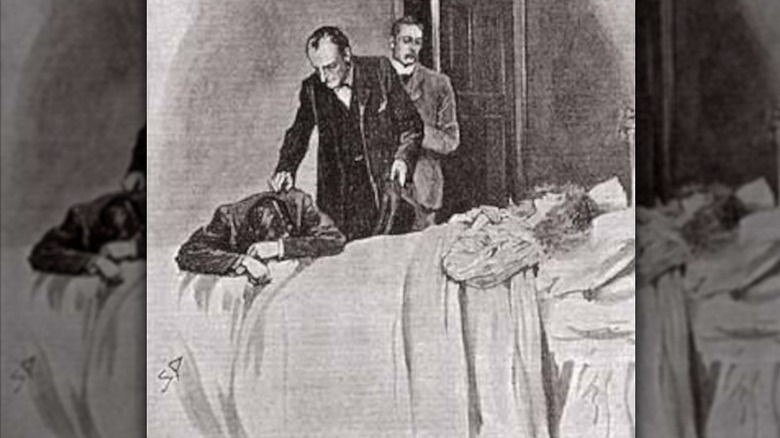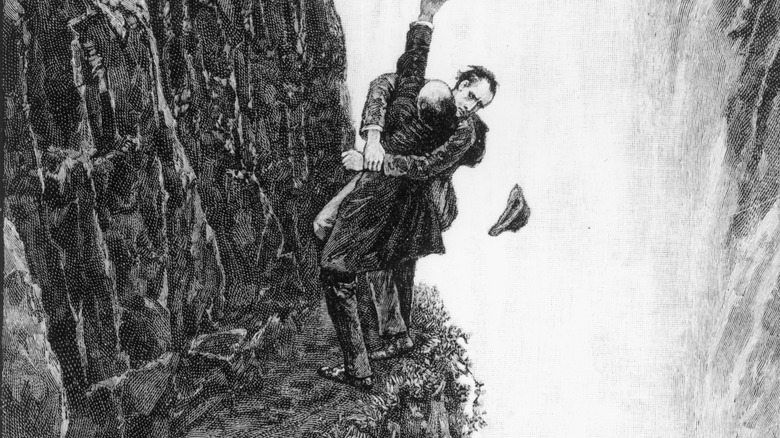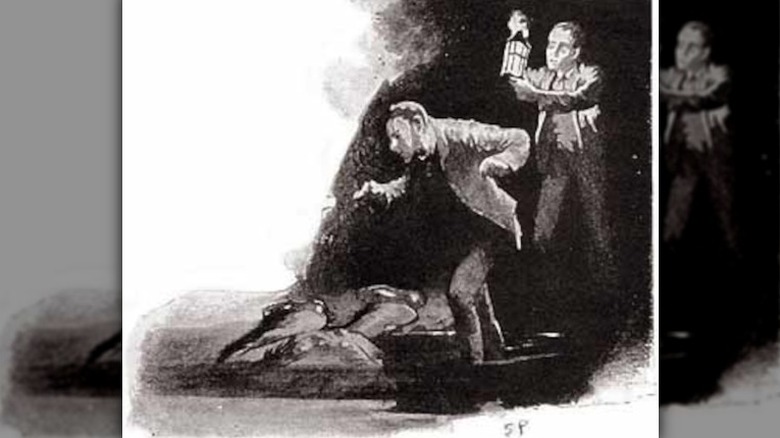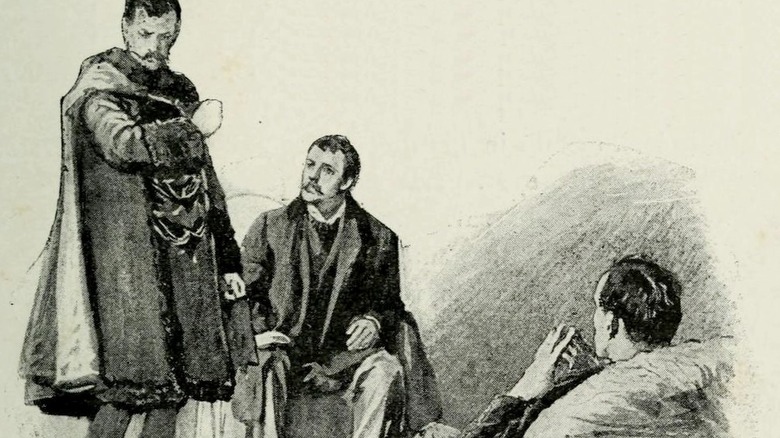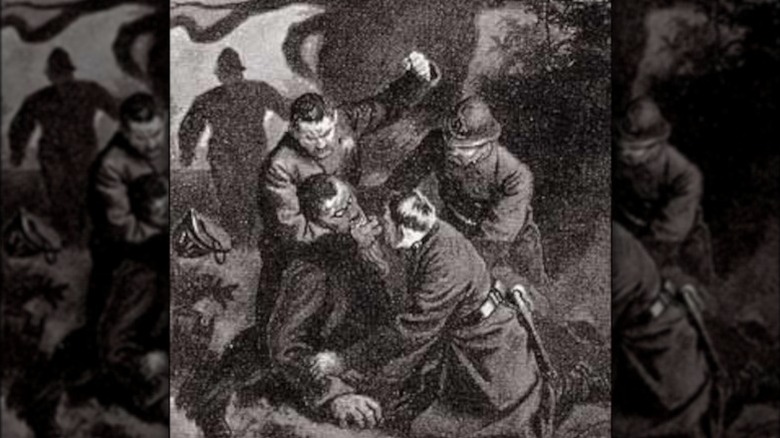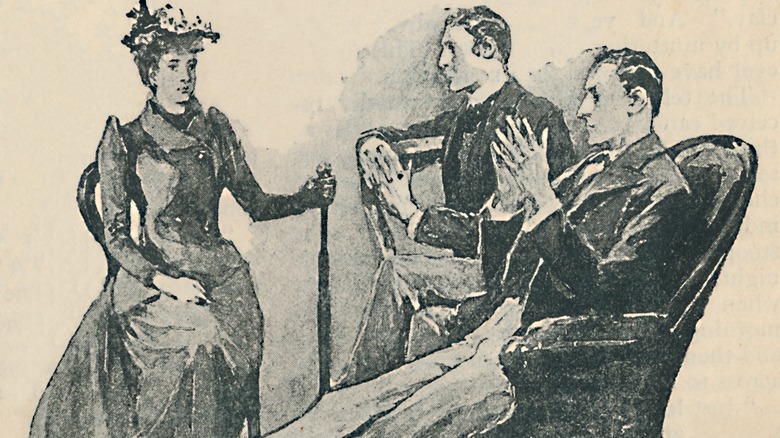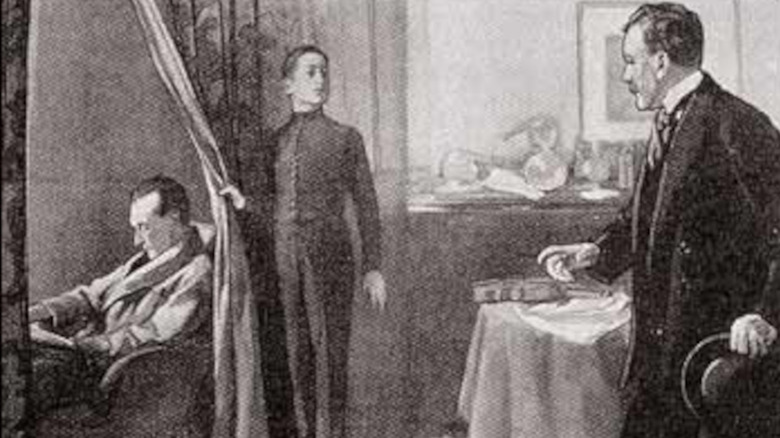The Best And Worst Sherlock Holmes Stories
Sherlock Holmes is one of the most evergreen fictional characters ever created. First introduced to the world in 1887 by Arthur Conan Doyle, Holmes' fastidious affect and unique detective style — utilizing observation and logic, often solving crimes simply by arranging clues in his mind — has kept him prominently in the public imagination ever since. Hardly a year goes by without some kind of adaptation of Sherlock Holmes, and plenty of modern-day fictional detectives owe a debt to the original gangster of intellectual sleuths.
Considering the enormous impact Holmes has had on pop culture, it's often surprising to realize Doyle only published four novels featuring the character. Holmes' true legacy is in the 56 short stories Doyle wrote about Holmes, stories that established not just Holmes and his assistant, Dr. Watson, as characters but also any number of detective fiction tropes and conventions.
As important and entertaining as Holmes is, however, not every one of these stories has stood the test of time. Yet, the best of the Holmes stories still seem fresh today and maintain their ability to surprise even the most attentive reader — without cheating. The worst of them, however, often feature some fairly shocking 19th-century attitudes (especially toward women and race) and even some pretty terrible mysteries. If you're just getting started with Sherlock Holmes, here are six of the best stories to read — and six you'd be better off avoiding.
Best: The Adventure of the Speckled Band
This might be the perfect Sherlock Holmes story. In fact, it suffers only one glaring defect: The overt racism employed in terms of the Romani characters in the story, who aren't only referred to with an ethnic slur but are also cast as obvious criminals and bad influences simply because they're Romani. Aside from that, however, the story is terrific. As noted by author Anthony Horowitz in Publishers Weekly, it was Arthur Conan Doyle's favorite of his own stories and has everything you think of when you think of Sherlock Holmes.
What makes it so good? First, there's the macabre, horror-movie ambiance. A woman comes to Holmes, distraught — her sister died while locked in her bedroom after being tormented for several nights by strange noises and happenings, and now she herself must sleep in the same room — and is hearing the same noises. The only clue? Her dead sister's dying words about a "speckled band." As noted by Barnes & Noble, the story is a legit "locked room" mystery, a seemingly impossible crime with a perfectly plausible solution.
Combined with the terrifying atmosphere, the fact that the crime is actually possible and the clues all coalesce to make sense once you know the solution makes this not just one of the best Sherlock Holmes stories, but one of the best mystery stories of all time, period.
Worst: The Adventure of the Three Gables
If you're wondering if racism was common practice in Victorian-era England, here's your answer: Very much, yes. The Guardian describes "The Adventure of the Three Gables" as "distasteful," noting the "caricature" treatment of the non-white characters. In the story, a Black man who was a former slave is described in excruciatingly racist terms (Holmes complains of his smell more than once), and there are stereotypical references to a "fiery" Spanish woman and Italian "cruelty." It's so blatant and dumb you almost wonder if it's a joke, but no, Arthur Conan Doyle actually wrote this stuff.
Worst of all, the story isn't good. Even putting the racism aside, it's easy to see why this story barely manages three stars on Goodreads. After a "huge negro" bursts into his home, Sherlock Holmes agrees to take on a strange but not exactly compelling case: A woman in a small English town has received an offer to purchase her house and all of its contents — every last item, including her personal items. Later the house is burgled and a manuscript written by the owner's son is stolen. The solution to the mystery is pretty humdrum, Holmes' manner of figuring it out is surprisingly reliant on coincidence and happenstance, and the final resolution is pretty tame. Not all stories can be bangers, but this one commits the worst sin in fiction: It's dull.
Best: The Adventure of the Red-Headed League
What makes "The Adventure of the Red-Headed League" so great is the combination of a clever mystery and a dose of good-humored fun, often lacking in the very straitlaced world of Sherlock Holmes.
In the story, Holmes and Watson are approached by a man named Jabez Wilson, owner of a failing pawnshop. Wilson, who has bright red hair, had answered an advertisement placed by the Red-Headed League seeking red-headed men for a job. Wilson was hired at a very high rate of pay and set to copying the encyclopedia. After a few weeks of this boring but profitable work, he arrived to find the league "dissolved." He wants Holmes to find out what the heck was going on.
As noted by The Art of Manliness, this story "shows the fun, playful side" of Doyle's writing. Although the mystery is a bit silly on its face, the explanation is plausible, and Holmes' manner of solving the mystery makes perfect sense once you piece it all together. Most importantly, as noted by Al Shaw in the book "About Sixty," the story combines everything we love about Holmes into one nearly-perfect whole: It's an "actual mystery" with a real investigation. It's a classic technique of opening with something bizarre and strange and then slowly explaining how it isn't bizarre or strange at all.
Worst: The Adventure of The Creeping Man
What sets Sherlock Holmes apart from other literary detectives is his reliance on data — Holmes solves mysteries by taking in information and then brilliantly assembling it into a solution. Holmes' ability to spot details and immediately see their importance is occasionally superhuman, but, in general, there's a sense of fair play and realism to the stories.
Except in "The Adventure of The Creeping Man," which (SPOILERS!) involves a man injecting himself with a drug extracted from (checks notes) monkeys in order to be virile for his much younger fiancee. You read that correctly: A man takes a drug that makes him behave like (and start to resemble) a monkey.
MX Publishing, which ranks this story at the very bottom of its list of Sherlock Holmes stories, calls it "Offal in nature if not by name," and Book Riot (which also ranks it in the bottom 10 of Arthur Conan Doyle's stories) notes "the weirdest part is when Holmes worries this will lead to a nation of monkey extract addicts." In "The Case-Book of Sherlock Holmes," author and academic David Stuart Davies calls the story "risible science fiction" and speculates that Doyle was aware of how bad it was, as he had announced it would be the last Holmes story after its publication (though Doyle's "retirement" from Holmes lasted just six months).
Best: The Adventure of Silver Blaze
Combining terrific atmosphere and detail with a sturdy mystery, "The Adventure of Silver Blaze" always seems to land in any Top Ten listing of Sherlock Holmes stories — in fact, in the book "About Sixty," author Elinor Gray calls it "the best story in the entire Sherlock Holmes collection." A clue to the lasting power of this story lies in this classic exchange:
Police detective: Is there any other point to which you would wish to draw my attention?
Holmes: To the curious incident of the dog in the night-time.
Police detective: The dog did nothing in the night-time.
Holmes: That was the curious incident.
The mystery is a master class of a puzzle that seems complex and almost supernatural until Holmes elucidates the details: A champion thoroughbred horse goes missing, his trainer appears to have been murdered, and some local sheep have been purposefully injured.
The solution makes perfect sense when it's laid out for you, and the journey there is enjoyable because of the setting and the very good writing. Best of all, this is a story where Sherlock Holmes really sings as a character, having sport with some of the duller people around him and basically being a lot of fun.
Worst: The Adventure of the Missing Three-Quarter
"The Adventure of the Missing Three-Quarter" is not a terrible story in the sense of being poorly written, but it's also creakingly dull — it's also not exactly an example of great writing; the ending of the story feels extremely tacked-on and rushed, with a shift in tone that makes it feel like Arthur Conan Doyle simply wanted to end the story and get it off to the printer.
As the story begins, Sherlock Holmes is contacted when a star rugby player, Godfrey Staunton, goes missing. Staunton's uncle is incredibly rich, so everyone expects a ransom note — but none comes, and Holmes runs into suspicious resistance from some of Staunton's close acquaintances. The rugby aspect brings some fresh atmosphere into the story at first, but this is quickly abandoned in favor of a pretty plodding and surprisingly procedural Holmes story.
Everything shifts suddenly when Holmes tracks a carriage to a remote cottage, and as Stephen Browning writes in "On the Trail of Sherlock Holmes," the story ends up a "sad tale." There's nothing wrong with a sad ending, but it simply doesn't jibe with the rest of the story, and isn't a particularly interesting mystery, either. As noted by History Today, the story is mostly remembered today as the story in which Sherlock Holmes kicks his cocaine habit, which had become something of a concern for Doyle as the understanding of addiction and the destructive power of the drug became more widely understood.
Best: The Final Problem
As noted by The Wall Street Journal, Arthur Conan Doyle invented Sherlock Holmes' arch-nemesis Professor Moriarty because he was tired of writing about Sherlock Holmes. He'd worked hard to make Holmes almost unbeatable, so he had to quickly come up with a villain that was more than a match for the brilliant detective with the sole intent of killing Holmes off in "The Final Problem."
The story isn't so much a mystery as a thriller: Holmes informs Watson that he's been tracking the activities of "The Napoleon of Crime" for some time, and is getting ready to purge London of this powerful criminal mastermind. But as noted by The Art of Manliness, Doyle plays with the reader's expectations by having Moriarty get the better of Holmes, and soon he and Watson are uncharacteristically on the run.
The result is a story The Strand Magazine calls "majestic ... full of drama, pathos, and menace." It crackles with energy as Holmes finally faces an enemy who is almost as smart as he is, and that by itself makes the story well worth reading. The famous ending, which sees Holmes and Moriarty go over the side of the Reichenbach Falls — apparently to both their deaths — caused quite a stir. The encyclopedia Britannica notes that 20,000 people canceled their subscription to Strand Magazine as a result, and people wore black armbands in protest. Doyle was convinced to resurrect Holmes a few years later.
Worst: The Five Orange Pips
"The Five Orange Pips" can be divisive among Sherlock Holmes fans. On the one hand, as noted by MX Publishing, the story has "a great first half" as Holmes investigates letters demanding that certain papers be returned, each containing dried-up orange seeds (or pips) and arriving in envelopes marked "KKK" (yes, that KKK). Doyle gets the history and purpose of the Ku Klux Klan correct, and Holmes is suitably disdainful of the terrorist group.
But the story collapses in the back half. Dr. Watson is upfront in the beginning that this is one of the only times Holmes actually outright fails, but that doesn't prepare the reader for the way the story just trails off with no arrest or other satisfying event — Holmes makes an effort at attaining justice, but it simply ... fails.
To be fair, the story suffers from the march of time. When first published in 1891, the KKK's reputation and fame had sunk, lending some mystery to the markings on the letters. In the modern age, the moment you see those letters you know exactly what organization sent them, and that solves most of the mystery for you, making this barely a problem worth solving.
Best: A Scandal in Bohemia
The first-ever short story featuring Sherlock Holmes is also one of the best overall. As noted by Interesting Literature, prior to its publication in The Strand Magazine, Holmes had seen minor success in Arthur Conan Doyle's first two novels — but "A Scandal in Bohemia" was a huge success and thrust Holmes into the spotlight.
In it, Holmes is visited by a masked gentleman soon revealed to be the grand duke of Cassel-Felstein and the heir to the throne of Bohemia. The duke admits that he had an affair with an American woman named Irene Adler and needs to acquire a photograph that she refuses to return to him. Holmes discovers the photo's hiding place, but before they can claim it, Adler turns the tables.
Adler's fame is in large part due to her brilliance as a character — she so thoroughly impresses Holmes that he refers to her only as "the woman" going forward. As observed by Dr. Watson, "To Sherlock Holmes, she is always the woman. I have seldom heard him mention her under any other name. In his eyes, she eclipses and predominates the whole of her sex" (via the Arthur Conan Doyle Literary Estate).
Most importantly, as Angela Misri notes in "About Sixty," the story "is the most humanizing" of the Sherlock Holmes stories, making Holmes a relatable person instead of a cold detection machine. That, coupled with a fine mystery that packs plenty of action, makes this a standout.
Worst: The Adventure of Wisteria Lodge
"The Adventure of Wisteria Lodge" starts off with what seems like a great mystery: An upstanding man of means, John Eccles, stays over at the house of a new friend named Aloysius Garcia. When he awakes, everyone is gone, including his host and all of the servants. While explaining this mystery to Holmes, the police arrive to announce that Garcia has been murdered.
From that promising start, Arthur Conan Doyle crafts a story that Book Riot describes (correctly) as "profoundly racist" and "way too long." The racism is hard to ignore — this isn't a few casual references you can attribute to old-timey attitudes, this is the baked-in sort of racism that sees all foreigners as monstrous demons — the phrase "hideous mulatto" appears unironically. Author Jessica Durgan notes in her book "Art, Race, and Fantastic Color Change in the Victorian Novel," that the "mulatto cook" is also described in a lazy, racist manner as stupid and graceless. It's not a good look.
The mystery itself is a bit convoluted and doesn't in any way justify the glacial pace and length of this story, though as noted by History Collection, "The Adventure of Wisteria Lodge" does introduce the only policeman that Holmes ever respected in Inspector Baynes. Baynes matches Holmes clue for clue and actually solves the mystery independently, somewhat undermining the usual Holmes myth and making this story even less satisfying as a result.
Best: The Adventure of the Copper Beeches
This story is simply a well-constructed, well-written Gothic mystery with plenty of creepy atmosphere and a liberal dose of much-needed humor. A young woman named Violet Hunter comes to Holmes because she has been offered a job at the country estate The Copper Beeches, but the job has a list of strange conditions. Holmes isn't sure he can help her, and she accepts the job. A few weeks later, she writes desperately to Holmes because things have gotten out of hand: She's required to spend her nights wearing a specific dress, reading with her back to a window; when she sneaks a mirror into the room, she sees a man staring at her from the road. And that's just one of many strange things happening.
"The Adventure of the Cooper Beeches" was first published in The Strand Magazine in June 1892, and while its plot is certainly a dark setup, there's a balance to the creepiness that keeps it from being truly horrifying. The solution to Miss Hunter's experience is plausible and rooted in greed, and is exposed in the classic manner of taking something seemingly supernatural and slowly revealing it to be tawdry and gross.
Aside from being one of the better mysteries in the Holmes canon, this story also features some terrific characters, like Violet Hunter (one of the few people, in general, Holmes seems to admire: "Pray take a seat, Miss Hunter. I shall be happy to do anything that I can to serve you."), and Inverse notes that the owner of Copper Beeches, Jephro Rucastle, is a "terrifying villain."
Worst: The Adventure of the Mazarin Stone
As author Jack Arthur Winn points out in the book "About Sixty," this story is one of just two not narrated by Dr. Watson, and all the action takes place in a single setting — Holmes' home. The reason for both of these features, according to the New York Public Library, is because the story was an adaptation of a one-act play Doyle had written called "The Crown Diamond." The play didn't involve Watson much, and its one-act nature kept it rooted in one location.
As noted in the book "Sherlock Holmes on the Stage," critic Jack Tracy called this story "the prime candidate for the very worst Sherlock Holmes story ever." It's easy to see why: The story begins with Watson arriving at Holmes' house to find a wax effigy of the detective in the window, designed as a decoy for a would-be assassin who is coming to murder Holmes. When the assassin arrives, there is some business with a record player in Holmes' bedroom, giving the illusion that Holmes is in there playing his violin while the detective uses a ridiculous secret passage to re-enter the main room of the apartment to surprise his attackers.
It's not an exciting story, and without Watson's unique voice, the story lacks any sort of style or flare. That, combined with a truly terrible mystery, dooms "The Adventure of the Mazarin Stone" to the "worst" list.
